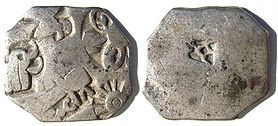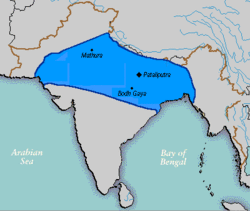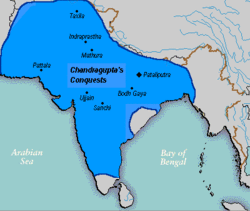- Chandragupta Maurya
-
Chandragupta Maurya Mauryan Emperor Reign 320–298 BCE Born 340 BCE Birthplace Patliputra (Patna), Bihar, India Died 298 BCE (aged 42) Place of death Sravana Belgola, Karnataka, India[1] Predecessor Dhanananda of Nanda Dynasty Successor Bindusara Consort Durdhara Royal House Mauryan dynasty Religious beliefs Hinduism for major part of life, Jainism in older days Chandragupt Maurya (Sanskrit: चन्द्रगुप्त मौर्य Hindi: चन्द्रगुप्त मौर्य), (born c. 340 BCE, ruled c. 320 BCE,[2] – 298 BCE[3]) was the founder of the Maurya Empire. Chandragupt succeeded in conquering most of the Indian subcontinent. Chandragupt is considered the first unifier of India and its first genuine emperor.[4] In foreign Greek and Latin accounts, Chandragupt is known as Sandrokyptos (Σανδρόκυπτος), Sandrokottos (Σανδρόκοττος) or Androcottus.[5]
Prior to Chandragupt's consolidation of power, small regional kingdoms dominated the northwestern subcontinent, while the Nanda Dynasty dominated the middle and lower basin of the Ganges.[6] After Chandragupt's conquests, the Maurya Empire extended from Bengal and Assam[7] in the east, to Afghanistan and Balochistan in the west, to Kashmir and Nepal[8] in the north, and to the Deccan Plateau in the south.[9]
His achievements, which ranged from conquering Macedonian satrapies in the northwest and conquering the Nanda Empire by the time he was only about 20 years old, to achieving an alliance with Seleucus I Nicator and establishing centralized rule throughout South Asia, remain some of the most celebrated in the history of India. Over two thousand years later, the accomplishments of Chandragupt stand out in the history of South Asia.
Contents
Origins
Many Indian literary traditions connect him with the Nanda Dynasty of Magadha in modern day Bihar in eastern India. More than half a millennium later, the Sanskrit drama Mudrarakshasa not only calls him Mauryaputra (Act II) but also a Nandanvaya (Act IV). Again more than a millennium later, Dhundiraja, a commentator of 18th century on Mudrarakshasa states that Chandragupta alias Maurya who, was son of the Nanda king Sarvarthasiddhi by a wife named Mura, daughter of a Vrishala (shudra). Mudrarakshasa uses terms like kula-hina and Vrishala for Chandragupta's lineage. This reinforces Justin's contention that Chandragupta had a humble origin.[10][11] On the other hand, the same play describes the Nandas as of Prathita-kula, i.e., illustrious lineage. The medieval commentator on the Vishnu Purana informs us that Chandragupta was son of a Nanda prince and a dasi (English: maid), mura. The poets Kshmendra and Somadeva call him Purvananda-suta, son of genuine Nanda as opposed to Yoga-Nanda, i.e., pseudo Nanda. Nanda dynasty was started by Mahapadma Nanda, who is considered, the first Shudra king of Magadha.
The Buddhist text of the Mahavamsa calls Chandragupta a section of the Khattya (Kshatriya) clan named Moriya (Maurya). Divyavadana calls Bindusara, son of Chandragupta, an anointed Kshatriya, Kshatriya Murdhabhishikata, and in the same work, king Ashoka, son of Bindusara, is also styled a Kshatriya. The Mahaparinnibhana Sutta of the Buddhist canon states that the Moriyas (Mauryas) belonged to the Kshatriya community of Pippalivana. These traditions, at least, indicate that Chandragupta has come from a Kshatriya lineage. The Mahavamshatika connects him with the Sakya clan of the Buddha, a clan which also belongs to the race of Aditya, i.e., solar race by all the vedas and Hindu puranas. See the page shakya for more details. All the puranas and vedas together proved shakya clan as a branch of ikshwaku vamsha or surya vamsha. All the Buddhist texts shows the genealogy of shakya kings of suryavamsha.
Ashok Maurya's inscription claiming to be 'Buddhi Sakya' further proves the Mauryas to be an offshoot of the Shakyas to whom 'Sakyamuni' Siddhartha Buddha belonged.
A medieval inscription represents the Maurya clan as belonging to the solar race of Kshatriyas. It is stated that the Maurya line sprang from Suryavamsi Mandhatri, son of prince Yuvanashva of the solar race.
Early life
Very little is known about Chandragupta's youth. what is known about his youth is gathered from later classical Sanskrit literature, as well as classical Greek and Latin sources which refer to Chandragupta by the names "Sandracottos" or "Andracottus". He was paragon for later rulers.
Plutarch reports that he met with Alexander the Great, probably around Takshasila in the northwest, and that he viewed the ruling Nanda Empire in a negative light:
“ "Androcottus, when he was a stripling, saw Alexander himself, and we are told that he often said in later times that Alexander narrowly missed making himself master of the country, since its king was hated and despised on account of his baseness and low birth." ” —Plutarch, Parallel Lives: Life of Alexander 62.9
According to this text, the encounter would have happened around 326 BCE, suggesting a birth date for Chandragupta around 340 BCE.Junianus Justinus (Justin) describes the humble origins of Chandragupta, and explains how he later led a popular uprising against the Nanda king.
Foundation of the Maurya Empire
Chandragupt Maurya, with the help of Chanakya, defeated the Magadha kings and the bulk army of Chandravanshi clan. Following his victory, defeated generals of Alexander settled in Gandhara (Kamboja kingdom of Aryan Mahajanpad), today's Afghanistan. At the time of Alexander's invasion, Chanakya was a teacher at Takshasila University. The king of Takshasila and Gandhara, Ambhi (also known as Taxiles), made signed a peace treaty with Alexander. Chanakya, however, planned to defeat the foreign invasion and sought help from other kings to unite and fight Alexander. Parvateshwar (Porus), a king of Punjab, was the only local king who was able to challenge Alexander at the Battle of the Hydaspes River, but was defeated.
Chanakya then went to Magadha further east, to seek the help of Dhana Nanda, who ruled a vast Nanda Empire which extended from Bihar and Bengal in the east to Punjab and Sindh in the west,[12] but he was denied any such help. After this incident, Chanakya started to convince his disciple Chandragupt of the need to build an empire that could protect Indian territories from foreign invasion.
Chanakya
Chandragupt's teacher and later his prime minister[13] Chanakya, who is also known as Kautilya and was the author of the Arthashastra, is regarded as the architect of Chandragupt's early rise to power. Chandragupt Maurya, with the help of Chanakya, began laying the foundation of the Maurya Empire. In all forms of the Chanakya legend,[14] he is thrown out of the Nanda court by the king, whereupon he swears revenge. While in Magadha, Chanakya by chance met Chandragupt in whom he spotted great military and executive abilities. Chanakya was impressed by the prince's personality and intelligence, and immediately took the young boy under his wing to fulfill his silent vow.
Nanda army
According to Plutarch, at the time of Alexander's Battle of the Hydaspes River, the size of the Nanda Empire's army further east numbered 200,000 infantry, 80,000 cavalry, 8,000 chariots, and 6,000 war elephants, which was discouraging for Alexander's men and stayed their further progress into India:
“ "As for the Macedonians, however, their struggle with Porus blunted their courage and stayed their further advance into India. For having had all they could do to repulse an enemy who mustered only twenty thousand infantry and two thousand horse, they violently opposed Alexander when he insisted on crossing the river Ganges also, the width of which, as they learned, was •thirty-two furlongs, its depth •a hundred fathoms, while its banks on the further side were covered with multitudes of men-at‑arms and horsemen and elephants. For they were told that the kings of the Ganderites and Praesii were awaiting them with eighty thousand horsemen, two hundred thousand footmen, eight thousand chariots, and six thousand fighting elephants. And there was no boasting in these reports. For Androcottus, who reigned there not long afterwards, made a present to Seleucus of five hundred elephants, and with an army of six hundred thousand men overran and subdued all India." ” —Plutarch, Parallel Lives, "Life of Alexander" 62.1-4
In order to defeat the powerful Nanda army, Chandragupta needed to raise a formidable army of his own.[12]
Conquest of the Nanda Empire
Main article: Nanda WarChanakya had trained Chandragupta under his guidance and together they planned the destruction of Dhana Nanda. The Mudrarakshasa of Visakhadutta as well as the Jaina work Parisishtaparvan talk of Chandragupta's alliance with the Himalayan king Parvatka, sometimes identified with Porus.[15]
It is noted in the Chandraguptakatha that the protagonist and Chanakya were initially rebuffed by the Nanda forces. Regardless, in the ensuing war, Chandragupta faced off against Bhadrasala – commander of Dhana Nanda's armies. He was eventually able to defeat Bhadrasala and Dhana Nanda in a series of battles, ending with the siege of the capital city Pataliputra[12] and the conquest of the Nanda Empire around 321 BCE,[12] thus founding the powerful Maurya Empire in Northern India by the time he was about 20 years old.
Conquest of Macedonian territories in India
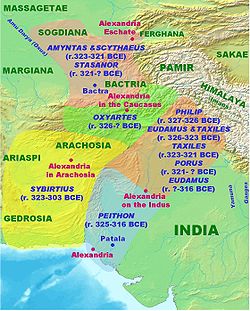 Chandragupta had defeated the remaining Macedonian satrapies in the northwest of the Indian subcontinent by 317 BCE.
Chandragupta had defeated the remaining Macedonian satrapies in the northwest of the Indian subcontinent by 317 BCE.
After Alexander's death in 323 BCE, Chandragupta, turned his attention to Northwestern India (modern Pakistan), where he defeated the satrapies (described as "prefects" in classical Western sources) left in place by Alexander (according to Justin), and may have assassinated two of his governors, Nicanor and Philip.[disambiguation needed
 ][4][12] The satrapies he fought may have included Eudemus, ruler in western Punjab until his departure in 317 BCE; and Peithon, son of Agenor, ruler of the Greek colonies along the Indus until his departure for Babylon in 316 BCE. The Roman historian Justin described how Sandrocottus (Greek version of Chandragupta's name) conquered the northwest:
][4][12] The satrapies he fought may have included Eudemus, ruler in western Punjab until his departure in 317 BCE; and Peithon, son of Agenor, ruler of the Greek colonies along the Indus until his departure for Babylon in 316 BCE. The Roman historian Justin described how Sandrocottus (Greek version of Chandragupta's name) conquered the northwest:“ "Some time after, as he was going to war with the generals of Alexander, a wild elephant of great bulk presented itself before him of its own accord, and, as if tamed down to gentleness, took him on its back, and became his guide in the war, and conspicuous in fields of battle. Sandrocottus, having thus acquired a throne, was in possession of India, when Seleucus was laying the foundations of his future greatness; who, after making a league with him, and settling his affairs in the east, proceeded to join in the war against Antigonus. As soon as the forces, therefore, of all the confederates were united, a battle was fought, in which Antigonus was slain, and his son Demetrius put to flight. " ” —Junianus Justinus, Historiarum Philippicarum libri XLIV, XV.4.19
Expansion
By the time he was only about 20 years old, Chandragupta, who had succeeded in defeating the Macedonian satrapies in India and conquering the Nanda Empire, had founded a vast empire that extended from the Bay of Bengal in the east, to the Indus River in the west, which he would further expand in later years.
Conquest of Seleucus' eastern territories
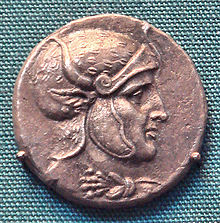 Silver coin of Seleucus I Nicator, who fought Chandragupta Maurya, and later made an alliance with him.
Silver coin of Seleucus I Nicator, who fought Chandragupta Maurya, and later made an alliance with him.
Seleucus I Nicator, a Macedonian satrap of Alexander, reconquered most of Alexander's former empire and put under his own authority eastern territories as far as Bactria and the Indus (Appian, History of Rome, The Syrian Wars 55), until in 305 BCE he entered in a confrontation with Chandragupta:
“ "Always lying in wait for the neighboring nations, strong in arms and persuasive in council, he acquired Mesopotamia, Armenia, 'Seleucid' Cappadocia, Persis, Parthia, Bactria, Arabia, Tapouria, Sogdia, Arachosia, Hyrcania, and other adjacent peoples that had been subdued by Alexander, as far as the river Indus, so that the boundaries of his empire were the most extensive in Asia after that of Alexander. The whole region from Phrygia to the Indus was subject to Seleucus. He crossed the Indus and waged war with Sandrocottus [Maurya], king of the Indians, who dwelt on the banks of that stream, until they came to an understanding with each other and contracted a marriage relationship. Some of these exploits were performed before the death of Antigonus and some afterward." ” The exact details of engagement are not known. As noted by scholars such as R. C. Majumdar[16] and D. D. Kosambi, Seleucus appears to have fared poorly, having ceded large territories west of the Indus to Chandragupta. Due to his defeat, Seleucus surrendered Arachosia, Gedrosia, Paropamisadae, and Aria.
Mainstream scholarship asserts that Chandragupta received vast territory west of the Indus, including the Hindu Kush, modern day Afghanistan, and the Balochistan province of Pakistan.[17][18] Archaeologically, concrete indications of Mauryan rule, such as the inscriptions of the Edicts of Ashoka, are known as far as Kandhahar in southern Afghanistan.
“ "After having made a treaty with him (Sandrakotos) and put in order the Orient situation, Seleucos went to war against Antigonus." ” —Junianus Justinus, Historiarum Philippicarum libri XLIV, XV.4.15
It is generally thought that Chandragupta married Seleucus's daughter, or a Greek Macedonian princess, a gift from Seleucus to formalize an alliance. In a return gesture, Chandragupta sent 500 war-elephants,[16][19][20][21][22][23] a military asset which would play a decisive role at the Battle of Ipsus in 302 BCE. In addition to this treaty, Seleucus dispatched an ambassador, Megasthenes, to Chandragupta, and later Deimakos to his son Bindusara, at the Mauryan court at Pataliputra (modern Patna in Bihar state). Later Ptolemy II Philadelphus, the ruler of Ptolemaic Egypt and contemporary of Ashoka the Great, is also recorded by Pliny the Elder as having sent an ambassador named Dionysius to the Mauryan court.[24]
Classical sources have also recorded that following their treaty, Chandragupta and Seleucus exchanged presents, such as when Chandragupta sent various aphrodisiacs to Seleucus:
“ "And Theophrastus says that some contrivances are of wondrous efficacy in such matters [as to make people more amorous]. And Phylarchus confirms him, by reference to some of the presents which Sandrakottus, the king of the Indians, sent to Seleucus; which were to act like charms in producing a wonderful degree of affection, while some, on the contrary, were to banish love." ” —Athenaeus of Naucratis
Southern conquests
After annexing Seleucus' eastern Persian provinces, Chandragupta had a vast empire extending across the northern parts of Indian Sub-continent, from the Bay of Bengal to the Arabian Sea. Chandragupta then began expanding his empire further south beyond the barrier of the Vindhya Range and into the Deccan Plateau except Tamil Country,Kalinga(modern day Orissa).[12] By the time his conquests were complete, Chandragupta succeeded in unifying most of Southern Asia. Megasthenes later recorded the size of Chandragupta's acquired army as 400,000 soldiers, according to Strabo:
“ "Megasthenes was in the camp of Sandrocottus, which consisted of 400,000 men" ” On the other hand, Pliny, who also drew from Megasthenes' work, gives even larger numbers of 600,000 infantry, 30,000 cavalry, and 9,000 war elephants:
“ "But the Prasii surpass in power and glory every other people, not only in this quarter, but one may say in all India, their capital Palibothra, a very large and wealthy city, after which some call the people itself the Palibothri,--nay even the whole tract along the Ganges. Their king has in his pay a standing army of 600,000-foot-soldiers, 30,000 cavalry, and 9,000 elephants: whence may be formed some conjecture as to the vastness of his resources." ” Jainism
Chandragupta gave up his throne towards the end of his life and became an ascetic under the Jain saint Bhadrabahu, migrating south with them and ending his days in sallekhana at Shravanabelagola, in present day Karnataka; though fifth-century inscriptions in the area support the concept of a larger southern migration around that time.[25] A small temple marks the cave (Bhadrabahu Cave) where he is said to have died by fasting.
There are two hills in Shravanabelagola, Chandragiri (Chikkabetta) and Vindyagiri. The last shruta-kevali, Bhadrabahu Swami, and his pupil, Chandragupta Maurya (formerly the King), are believed to have meditated here. Chandragupta Basadi, which was dedicated to Emperor Chandragupta Maurya, was originally built there by Emperor Ashoka in the third century BC.
Successors
Chandragupta Maurya renounced his throne to his son, Bindusara, who became the new Mauryan Emperor. Bindusara's son Ashoka the Great, became one of the most influential kings in India's history due to his important role in the history of Buddhism. Ashoka the Great after witnessing the results of his wars, became a devoted Buddhist and a man of peace.
In popular culture
Kautilya's role in the formation of the Mauryan Empire is the essence of a historical/spiritual novel The Courtesan and the Sadhu by Dr. Mysore N. Prakash.[26]
In Santosh Sivan's 2001 epic Hindi language film Asoka, the last moments of Chandra Gupta Maurya as an emperor is portrayed. Also the sword of Chandra Gupta Maurya plays an important role in the film. The film opens with an old and tired Chandragupta Maurya giving away all his material possessions and taking the life of a Jain saint. His favorite grandson, prince Asoka, claims his grandfather's sword. Chandra Gupta Maurya explains that the sword is in fact a demon that, whenever unsheathed, craves blood without regard to friend or foe. He throws away the sword but the young prince Asoka reclaims and unsheathes it whereupon it accidentally slashes his dear birds on a tree. At one point, Emperor Asoka mentions that he "want to be a greater emperor than Chandra Gupta Maurya". The film ends with Emperor Asoka throwing the sword at the same spot his grandfather, Chandragupta Maurya, had thrown it and embracing Buddhism. Emperor Asoka understands that his grandfather's advice about the sword was right.
- Television series Chanakya is archetypal account of the life and times of Chanakya, based on the play "Mudra Rakshasa" (The Signet Ring of "Rakshasa")
- A Television series on Imagine TV available as "Chandragupta Maurya" (The serial is based on the life of Indian ruler "Chandragupta Maurya" and "Chanakya")[27]
See also
- Bhagrathi community (Western UP)
- Ancient Macedonian army
- Arthashastra
- Ashoka
- Bindusara
- Chanakya
- Dasaratha Maurya
- Greco-Bactrian
- Gupta
- Indo-Greek Kingdom
- List of Indian monarchs
- List of people known as The Great
- Mauryan art
References
- ^ Chandragupt Maurya and his times By Radhakumud Mookerji,Pg.no.40
- ^ Kulke, Hermann; Rothermund, Dietmar (1998) [1986]. A History of India (Third ed.). London: Routledge. pp. 59. ISBN 0-415-15481-2.
- ^ Kulke and Rothermund 1998:62
- ^ a b Boesche, Roger (January 2003). "Kautilya's Arthaśāstra on War and Diplomacy in Ancient India". The Journal of Military History 67 (1): 9–37. doi:10.1353/jmh.2003.0006. ISSN 0899-3718. http://muse.jhu.edu/demo/journal_of_military_history/v067/67.1boesche.pdf.
- ^ William Smith (ed), Dictionary of Greek and Roman Biography and Mythology, 1870, Vol 3 p. 705-6
- ^ Shastri, Nilakantha (1967). Age of the Nandas and Mauryas. Delhi: Motilal Banarsidass. p. 26. ISBN 81-208-0465-1.
- ^ Vaughn, Bruce (2004). "Indian Geopolitics, the United States and Evolving Correlates of Power in Asia". Geopolitics 9 (2): 440–459 [442]. doi:10.1080/14650040490442944.
- ^ Goetz, H. (1955). "Early Indian Sculptures from Nepal". Artibus Asiae 18 (1): 61–74. doi:10.2307/3248838.
- ^ The Span of the Mauryan Empire, Kamat's Potpurri, accessed 9 September 2007
- ^ "He (Seleucus) next made an expedition into India, which, after the death of Alexander, had shaken, as it were, the yoke of servitude from its neck, and put his governors to death. The author of this liberation was Sandrocottus, who afterwards, however, turned their semblance of liberty into slavery; for, making himself king, he oppressed the people whom he had delivered from a foreign power, with a cruel tyranny. This man was of mean origin, but was stimulated to aspire to regal power by supernatural encouragement; for, having offended Alexander by his boldness of speech, and orders being given to kill him, he saved himself by swiftness of foot; and while he was lying asleep, after his fatigue, a lion of great size having come up to him, licked off with his tongue the sweat that was running from him, and after gently waking him, left him. Being first prompted by this prodigy to conceive hopes of royal dignity, he drew together a band of robbers, and solicited the Indians to support his new sovereignty. Some time after, as he was going to war with the generals of Alexander, a wild elephant of great bulk presented itself before him of its own accord, and, as if tamed down to gentleness, took him on its back, and became his guide in the war, and conspicuous in fields of battle. Sandrocottus, having thus acquired a throne, was in possession of India" (Justin "Epitome of the Philippic History" XV-4)
- ^ There is a controversy about Justin's account. Justin actually refers to a name Nandrum, which many scholars believe is reference to Nanda (Dhana Nanda of Magadha), while others say that it refers to Alexandrum, i.e., Alexander. It makes some difference which version one believes
- ^ a b c d e f Radha Kumud Mookerji, Chandragupta Maurya and His Times, 4th ed. (Delhi: Motilal Banarsidass, 1988 [1966]), pp. 31, 28–33.
- ^ Boesche, Roger (January 2003). "Kautilya's Arthaśāstra on War and Diplomacy in Ancient India". The Journal of Military History 67 (1): 9–37. doi:10.1353/jmh.2003.0006. ISSN 0899-3718. http://muse.jhu.edu/demo/journal_of_military_history/v067/67.1boesche.pdf. "Kautilya [is] sometimes called a Chancellor or Prime Minister to Chandragupt, something like a Bismarck..."
- ^ Trautmann, Thomas R. (1971). "The Cāṇakya-Candragupta-Kathā". Kauṭilya and the Arthaśāstra: A Statistical Investigation of the Authorship and Evolution of the Text. Leiden: E.J. Brill.
- ^ John Marshall Taxila, p. 18, and al.
- ^ a b Ramesh Chandra Majumdar (1977). Ancient India. Motilal Banarsidass Publ. ISBN 8120804368.
- ^ Vincent A. Smith (1998). Asoka. Asian Educational Services. ISBN 8120613031.
- ^ Walter Eugene, Clark (1919). "The Importance of Hellenism from the Point of View of Indic-Philology". Classical Philology 14 (4): 297–313. doi:10.1086/360246.
- ^ Ancient India, (Kachroo ,p.196)
- ^ The Imperial Gazetteer of India, (Hunter,p.167)
- ^ The evolution of man and society, (Darlington ,p.223)
- ^ Tarn, W. W. (1940). "Two Notes on Seleucid History: 1. Seleucus' 500 Elephants, 2. Tarmita". The Journal of Hellenic Studies 60: 84–94. doi:10.2307/626263.
- ^ Partha Sarathi Bose (2003). Alexander the Great's Art of Strategy. Gotham Books. ISBN 1592400531.
- ^ Pliny the Elder, "The Natural History", Chap. 21
- ^ Digambaras, Overview of World Religions, accessed 9 September 2007
- ^ The Courtesan and the Sadhu, A Novel about Maya, Dharma, and God, October 2008, Dharma Vision LLC., ISBN 978-0-9818237-0-6, Library of Congress Control Number: 2008934274
- ^ TV, Imagine. "Channel". TV Channel. http://www.imagine.tv/in/shows/subhome/123/1779/.
Further reading
- Kosambi, D.D. An Introduction to the Study of Indian History, Bombay: Popular Prakashan, 1985
- Bhargava, P.L. Chandragupta Maurya, New Delhi:D.K. Printworld, 160 pp., 2002.
- Habib, Irfan. and Jha, Vivekanand. Mauryan India: A People's History of India,New Delhi:Tulika Books, 2004; 189pp
- Vishakadatta, R.S. Pandit.Mudraraksasa (The Signet Ring of Rakshasa), New Delhi:Global Vision Publishing House, 2004, ISBN 81-8220-009-1, edited by Ramesh Chandra
- Swearer, Donald. Buddhism and Society in Southeast Asia (Chambersburg, Pennsylvania: Anima Books, 1981) ISBN 0-89012-023-4
- Nilakanta Sastri, K. A. Age of the Nandas and Mauryas (Delhi : Motilal Banarsidass, [1967] c1952) ISBN 0-89684-167-7
- Bongard-Levin, G. M. Mauryan India (Stosius Inc/Advent Books Division May 1986) ISBN 0-86590-826-5
- Chand Chauhan, Gian. Origin and Growth of Feudalism in Early India: From the Mauryas to AD 650 (Munshiram Manoharlal January 2004) ISBN 81-215-1028-7
- Keay, John. India: A History (Grove Press; 1 Grove Pr edition May 10, 2001) ISBN 0-8021-3797-0
- Radha Kumud Mukherji. Chandragupta Maurya aur Uska Kaal (Rajkamal Prakashan, Re Print 1990) ISBN-81-7171-088-1
External links
- Shepherd boy Chandragupta Maurya
- 1911encyclopedia.org article on Chandragupta Maurya
- Chandragupta Maurya by Purushottam Lal Bhargava (BTM format)
Preceded by
Nanda DynastyMauryan Emperor
322–298 BCSucceeded by
BindusaraCategories:- 298 BC deaths
- Jain monarchs
- Indian monarchs
- Mauryan dynasty
- Santhara
- 3rd-century BC rulers
- 4th-century BC rulers
- 340 BC births
Wikimedia Foundation. 2010.

